Related Research Articles

Horse racing is the second largest spectator sport in Great Britain, and one of the longest established, with a history dating back many centuries. According to a report by the British Horseracing Authority it generates £3.39 billion total direct and indirect expenditure in the British economy, of which £1.05 Billion is from core racing industry expenditure and the major horse racing events such as Royal Ascot and Cheltenham Festival are important dates in the British and international sporting and society calendar.
In horse racing in the United Kingdom, France and Republic of Ireland, National Hunt racing requires horses to jump fences and ditches. National Hunt racing in the UK is informally known as "jumps" and is divided into two major distinct branches: hurdles and steeplechases. Alongside these there are "bumpers", which are National Hunt flat races. In a hurdles race, the horses jump over obstacles called hurdles; in a steeplechase the horses jump over a variety of obstacles that can include plain fences, water jump or an open ditch. In the UK, the biggest National Hunt events of the year are generally considered to be the Grand National and the Cheltenham Gold Cup.
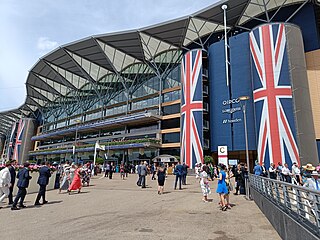
Ascot Racecourse is a dual-purpose British racecourse, located in Ascot, Berkshire, England, about 25 miles west of London. Ascot is used for thoroughbred horse racing, and it hosts 13 of Britain's 36 annual Flat Group 1 horse races and three Grade 1 Jumps races.

Aintree Racecourse is a racecourse in Aintree, Metropolitan Borough of Sefton, Merseyside, England, bordering the city of Liverpool. The racecourse is the venue for the Grand National steeplechase, which takes place annually in April over three days. Aintree also holds meetings in May and June, October (Sunday), November and December.
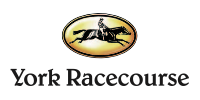
York Racecourse is a horse racing venue in York, North Yorkshire, England. It is the third biggest racecourse in Britain in terms of total prize money offered, and second behind Ascot in prize money offered per meeting. It attracts around 350,000 racegoers per year and stages three of the UK's 36 annual Group 1 races – the Juddmonte International Stakes, the Nunthorpe Stakes and the Yorkshire Oaks.

Newbury Racecourse is a racecourse and events venue in the civil parish of Greenham, adjoining the town of Newbury in Berkshire, England. It has courses for flat races and over jumps. It hosts one of Great Britain's 36 annual Group 1 flat races, the Lockinge Stakes.

Cheltenham Racecourse at Prestbury Park, near Cheltenham, Gloucestershire, England, hosts National Hunt horse racing. Racing at Cheltenham took place in 1815, but comprised only minor flat races on Nottingham Hill. The first racing on Cleeve Hill was on Tuesday 25 August 1818 when the opening race was won by Miss Tidmarsh, owned by Mr E Jones. It was a year later when the results were printed in the Racing Calendar when a programme of flat racing was watched by the Duke of Gloucester who donated 100 Guineas to the prize fund. By 1831 races were being staged at Prestbury, although not on the present day course. In 1834 the Grand Annual Steeplechase was run for the first time. In 1839 Lottery won the Grand Annual having previously won the first Aintree Grand National. In 1840 the meeting transferred to Andoversford for a brief period, only to return to Prestbury in 1847. 1902 was a notable year in that racing moved to the present course at Prestbury Park. The new stands were completed in 1914 and the present day Festival races, as we know them, began to take shape. The Cheltenham Gold Cup, over 3 ¼ miles, was run for the first time in 1924, with the Champion Hurdle following in 1927.
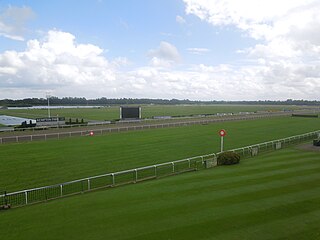
Kempton Park Racecourse is a horse racing track together with a licensed entertainment and conference venue in Sunbury-on-Thames, Surrey, England, near the border with Greater London; it is 16 miles south-west of Charing Cross in central London. The site has 210 acres of flat grassland surrounded by woodland with two lakes in its centre. Its entrance borders Kempton Park railway station which was created for racegoers on a branch line from London Waterloo, via Clapham Junction.
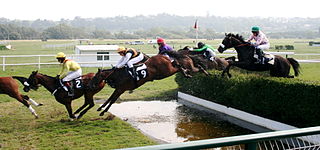
A steeplechase is a distance horse race in which competitors are required to jump diverse fence and ditch obstacles. Steeplechasing is primarily conducted in Ireland, the United Kingdom, Canada, United States, Australia, and France. The name is derived from early races in which orientation of the course was by reference to a church steeple, jumping fences and ditches and generally traversing the many intervening obstacles in the countryside.
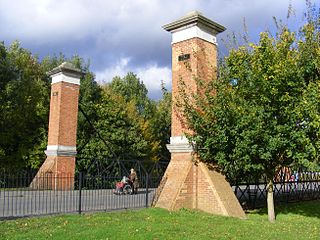
Hurst Park Racecourse was a racecourse at Moulsey Hurst, West Molesey, Surrey, near the River Thames. It was first laid out in 1890 and held its last race in 1962.

Cartmel Racecourse is a small national hunt racecourse in the village of Cartmel, now in the ceremonial county of Cumbria, historically in Lancashire. Nine racedays are held each year, starting on the Whit Holiday weekend at the end of May and ending on the August Bank Holiday weekend in August Bank Holidays.

Exeter Racecourse is a thoroughbred horse racing venue located near the city of Exeter, Devon, England. Locally it is known as Haldon racecourse because of its location on top of the Haldon Hills. Until the early 1990s it was officially known as Devon and Exeter.

Folkestone Racecourse was a thoroughbred horse racing venue in southeast England, until it closed in 2012. It is located in Westenhanger, by junction 11 of the M20 motorway and about 6 miles (9.7 km) west of Folkestone. The course remains closed and all running rail and steeplechase fences have been removed. In May 2016 it was revealed that the land covered by the racecourse forms part of a plan to develop and build housing. It is now unkempt and in a state of disrepair.
Sedgefield Racecourse is an English left-handed horse racing course, used for jump racing. It is owned by Arena Racing Company and located close to the town of Sedgefield, County Durham.
The Oakbank Easter Racing Carnival is a horse-racing meeting held over two days by the Oakbank Racing Club at the Oakbank Racecourse located in the Adelaide Hills in South Australia. The carnival is a mixture of flat and jumping races with between two and four jumps races on day one and two feature jumping races on day two.
The Grand Annual is an Australian Thoroughbred steeplechase for horses that run at Warrnambool, Victoria during its annual May Racing Carnival. The distance is officially listed as about 5500 metres because many sections of the race are run in open paddocks with little or no fences. The race is the longest horse race run in Australia on a public course. There are 33 obstacles, more than any other steeplechase in the world.

Manchester Racecourse was a venue for horse racing located at a number of sites around the Manchester area including; Kersal Moor, New Barns, Weaste and Castle Irwell, Pendleton, then in Lancashire. The final home of the course, Castle Irwell, was closed in 1963. Despite its name, the course was never actually located within the boundaries of the ancient township of Manchester or the subsequent city of Manchester.

Oakbank Racecourse, also but less frequently known as the "Onkaparinga Racecourse", is home of the Oakbank Racing Club, a club which, until 2009, raced just twice annually, Easter Saturday and Easter Monday at the Oakbank Easter Racing Carnival, and has done continually since 1876, except during World War II when it was held at Victoria Park and Morphettville Racecourse due to the army taking over the facility.
Horse racing in Wales has a long tradition dating back to the 18th century. Wales has held flat racing, National Hunt and harness racing, and presently has three racecourses, at Chepstow, Bangor-on-Dee and Ffos Las. The Welsh Grand National is held annually at Chepstow between Christmas and New Year and is the highlight of the Welsh racing calendar.
Blackpool Squires Gate Greyhound Stadium was a greyhound track in Blackpool, Lancashire. It is not to be confused with the Blackpool St Annes Greyhound Stadium that was nearby but to the north.
References
- 1 2 3 4 5 6 7 8 9 10 "Lost racecourses 8: Clifton Park, Blackpool". geegeez.co.uk. 1 August 2013. Retrieved 14 October 2023.
- 1 2 3 4 "Blackpool Racecourse". Greyhound Derby. Retrieved 14 October 2023.
- ↑ "Blackpool Steeplechase Programme" . Blackpool Herald. 3 March 1911. p. 6. Retrieved 15 February 2024– via British Newspaper Archive.
- ↑ "Clifton Park" . Blackpool Herald. 18 July 1911. p. 5. Retrieved 15 February 2024– via British Newspaper Archive.
- 1 2 3 4 "Under starter's orders on Blackpool's lost racecourse nearly 120 years ago". Blackpool Gazette. 2 August 2018. Retrieved 14 October 2023.